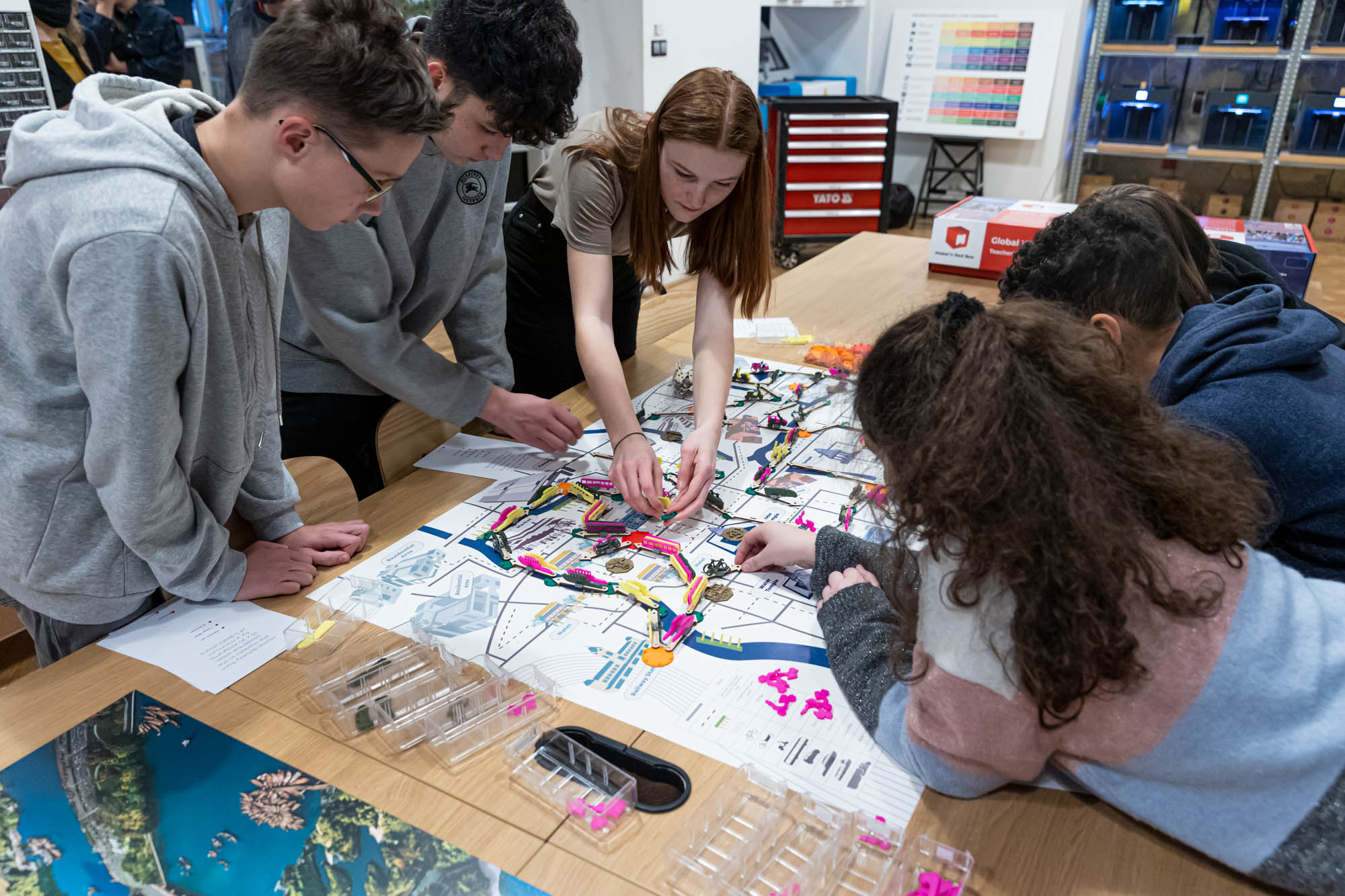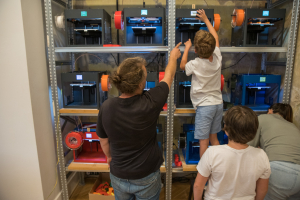Unleash the power of maker education

FUTURE IN THE MAKING
If there’s something the coronavirus pandemic has made abundantly clear, it is that digital education is more than just moving the classroom to Zoom. Granted, technology has saved the day in the face of “the greatest shake-up in education in a century”, but it has also highlighted startling digital divides. Not only in terms of school and student access to digital tools but also in terms of opportunity to embed them in learning and teaching practices in meaningful ways, a recent paper has found.
Online educations worked much better where teachers had greater agency and were used to project-based teaching. Sadly, students in more traditional educational systems did worse, pointed out the OECD’s Andreas Schleicher among the key pandemic lessons learned at the first-ever T4 global teachers’ online conference. The time is now to realign teaching materials and adopt new methodologies to equip today’s youth with the skills they'll need to succeed in their digital futures.
Many of today’s school children will work in jobs that are not even around yet, experts say. Still, it is already clear that tech savvy is far from being the only skill they will need to navigate this brave new digital world. The Society of Human Resource Management has found that soft skills such as problem-solving, critical thinking, innovation, and creativity are the top qualities employers are missing in today’s job applicants, regardless of industry or job type.
According to the latest data from LinkedIn human-centric soft skills are the most wanted, with creativity, persuasion, collaboration, adaptability, and emotional intelligence topping the list. In other words, skills people need when working with others to come up with new ideas and then to make them a reality. The hottest hard skills are the ones that determine what they should be working towards – think analytical reasoning, business analysis and other data-related skills.
Maker education prepares today’s youth for the challenges of the future. It’s a movement, a methodology, a mindset, and a community all at once that blends hard and soft skills development with a design focus. In this booklet, we’ll take a closer look at how and why maker pedagogy works, who can benefit from it and, most importantly, how it helps kids become the thinkers, creators, problem-solvers, and innovators that tomorrow’s workplaces will need.
HOW DOES MAKER EDUCATION WORK?
Makers are challenged to think, create, and solve problems using a mix of traditional crafts and digital technology, such as 3D printing, laser cutting, sewing, or programming. Maker education takes place in so-called makerspaces, sometimes called fab labs, innovation labs or STEAM labs. They are usually set up in libraries, schools and public community centres and are equipped with prototyping technology, including 3D printers, microcontrollers, soldering stations and laser cutters. But that doesn’t mean they’re simple production sites. Before anything else, a makerspace is an environment that turns passive students into active makers.
It guides kids through the creative learning spiral6 of imagine, create, play, share, reflect and repeat, a process extensively studied and documented by MIT Media Lab’s Mitchell Resnick. In his book, Lifelong Kindergarten, the renowned learning researcher, and Scratch Team founder argues that children engage in a creative learning process that has four pillars: projects, passions, peers, and play.
Cultivating this capability in children can give them a serious head start in the workplace of the future. How so? “Modern creative workplaces look much more like kindergartens than they look like high school classrooms,” explains MIT Assistant Professor Justin Reich. “Rather than lined up in rows working in sync on identical tasks, people gather in small groups, take on challenges, and have some measure of autonomy and choice about how they move through the day.”
WHY DOES IT WORK?
In traditional educational settings, students are asked to keep quiet, work alone and follow instructions. All they need to do is open their textbooks to find the right answer to any question. Then they move into the world of work and suddenly, they’re expected to do the opposite: collaborate with others, perform tasks with minimal guidance, solve problems using their creativity and find answers anywhere. Problem- and inquiry-based learning can make this transition much easier. Maker education focuses on motivating children to explore, design and create – and learn along the way.
Working with their own hands as they build 3D printed cities, laser cut robots or machine prototypes offers a stronger drive to succeed, a greater awareness of their environment and a deeper understanding of the course material than any other form of education. The reason is simple7: in makerspaces, students become engaged in shaping and bettering the world around them, not just using it.
Makers not only discover8 new ways of thinking and doing but also develop an appreciation for STEAM disciplines and their own STEAM capacities. Meanwhile, they build confidence, resourcefulness, and persistence. Collaborative learning and hands-on creation also challenge them to apply the 4 C’s of 21st-century skills, that is, critical thinking, creativity, collaboration, and communication, as well as prepare them to become productive members of a global workforce and society.
DO KIDS REALLY LEARN WILE MAKING?
When we ask kids after a creative session in the makerspace what they’ve learned, they usually say: “Nothing. We’ve played the entire time.” But if you ask them whether they’ve measured angles, calculated percentages, or learned something new about history, the answer will be a resounding yes. It’s quite incredible how much knowledge can be shared through hands-on teaching and how immersive a learning experience it can offer to kids.
Especially when combined with the oldest form of teaching: storytelling. For example, learning about Mars might sound interesting to some students. But tell a class that they’re now a team of astronauts whose mission is to travel to the red planet and survive after a crash landing, relying only on each other and their scientific knowledge and skills – and everyone gets excited. Not only the ones who excel at science but also those who are lagging behind.
Learning and working towards a specific goal at the same time, however, can pose a significant cognitive burden for makers, leaving little to no room for the reflection needed for long-term retention of knowledge. “Student makers may produce a handsome model airplane having no idea what makes it fly. The best way to ensure learning is to provide direct instruction: clear, straightforward explanation, offered before any making has begun,” sums up science journalist Annie Murphy Paul.
DOES MAKER EDUCATION ENGAGE ALL STUDENTS?
Constructionist pedagogy is based on the idea that children are not empty vessels to be filled with information, but active builders of knowledge. As the renowned Swiss philosopher and psychologist Jean Piaget explained10: “Children have real understanding only of that which they invent themselves, and each time that we try to teach them something too quickly, we keep them from reinventing it themselves.” In other words, they gain knowledge by interacting with the world and building knowledge structures based on their own experiences.
Besides giving learners agency and authorship, active learning also helps teachers contextualize scientific concepts and encourage STEM interest in children. In fact, disciplinary boundaries are against everything the maker movement stands for. In their paper, Making and Tinkering: A Review of the Literature11, Shirin Vossoughi and Bronwyn Bevan cite: “the ‘blending of traditional and digital tools, arts and engineering can create a learning environment with multiple entry points that foster innovative combinations, juxtapositions, and uses of disciplinary content and skill.’”
IS MAKER ED ABOUT TURNNG KINDS INTO ENGINEERS?
Only if they want to. But first and foremost, maker education aims at helping kids find their passion, realize their potential and live fulfilling, productive lives as adults, no matter what profession they eventually choose for themselves. Maker education activities let them explore whether it is design, management, production, or something else that suits them best. In makerspaces, STEM education evolves into STEAM, with an A for the arts, added for creativity and innovation – and a range of further benefits for both student and teacher efficacy.
A mixed-method study from 201412, for example, found that arts-integrated instruction can boost children’s academic and cognitive competencies and successfully engage lower-performing students and students with disabilities. The research was conducted in six high-poverty public elementary schools in New York City with a high percentage of English learners and special education students. The results showed that combining visual arts, literacy and maths not only increases students’ literacy, artistic and maths skills but also helps them meaningfully reflect on their own work and that of their peers.
WHO CAM BECOME A MAKER EDUCATOR?
Engineers, artists, teachers, designers – or anyone, really. With the wide range of user-friendly and affordable digital tools available for education, this is getting easier by the day. Background does not matter as long as teachers are willing to take the time to learn how to use and make the most of new technologies. Teachers working with ed tech equipment already know that there is an abundance of new tools available. But there is little time to find the right device and methodology. This is where maker education teaching materials and communities of maker educators can provide guidance.
WHAT ARE THE LIMITS OF THE MAKER EDUCATION?
Makers’ creativity knows no boundaries, but educational technology does. For example, you cannot print metals with the 3D printers you find in most makerspaces (although you can cast metals from 3D prints), and there are some materials that laser cutters are just not powerful enough for. Plus, unlike soft skills, hard skills development has some limitations in a makerspace environment. With maker technologies, there is a certain level of knowledge makers can reach, after which it is best for them to continue their education outside of the makerspace, for example, at university.

